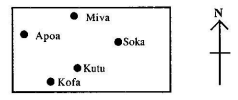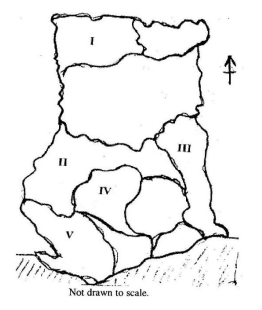1.
The environment can best be described as
man and his surrounding.
animals and non-living things.
vegetation and non-living things.
man and the vegetation around him.
2.
The social environment includes
settlements, churches and rivers.
settlements, festivals and political parties.
festivals, political parties and religious groups.
festivals, churches and tourist sites.
3.
Which of the following statements is true? The
social and physical environments are inter-dependent.
physical environment is independent of the social environment.
physical environment is never affected by the social environment.
social environment is more important than the physical environment.
4.
A major environmental problem facing municipal and metropolitan assemblies in Ghana is
waste management.
air pollution.
deforestation.
gully erosion
5.
Adolescent reproductive health aims at providing education on
good nutrition.
sexually.
good marriage.
security.
6.
The period of adolescence is
10 - 19 years.
10 - 14 years.
15 - 19 years.
12 - 19 years.
7.
One way of managing conflict in the Ghanaian society is
arbitration.
confrontation.
mediation.
consultation.
8.
Adolescent chastity is important because it prevents
contraction of HIV/AIDS by the youth.
contraction of malaria by the youth.
the effect of peer pressure on the youth.
the occurrence of broken homes.
9.
Adolescents who engage in early sex, risk
dropping out of school.
increasing the size of their family.
looking older than their age.
losing their parents.
10.
The part of one's income which is not spent is one's
insurance.
account.
deposit.
savings.
11.
During their migration, the Akan first settled at
Bono Manso.
Dormaa Ahenkro.
Asante Manso.
Denkyira.
12.
Ethnic conflicts must be avoided because they slow down
economic development.
rural-urban migration.
tribal disintegration.
urban-rural migration.
13.
Unity among Ghanaians can best be promoted through
inter-ethnic migration.
formal education.
opinion leaders.
good environmental practice.
14.
Which of the following represents the earth's surface or part of it drawn to scale?
Layout
Sketch
Map
Landmark
15.
Which of the towns in the sketch below lies directly south of Miva?

Kofa
Aposa
Soka
Kutu
16.
An important feature which can be used to show direction in a locality is called
landmark
bearing
compass
scale
17.
The ratio between distance measured on a map and the actual distance on the ground is a
scale
layout
statement
sketch
18.
The diagram below illustrates a

linear scale.
statement scale.
representative fraction.
railway line.
19.
If the scale of a map is 1:10,000 cm and the distance on the map is 20cm, then the actual distance on the ground is
20km
0.2km
2km
20,000km
20.
The principle of checks and balances prevents
constitutionalism
democracy
dictatorship
patriotism
21.
One way of sustaining unity among the ethnic groups in Ghana is by
selecting leaders through elections.
allowing people to enjoy free movement.
appreciating the cultural practices of other people.
keeping troublemakers in prison.
22.
One reason for the migration of many ethnic groups into Ghana is
education
security
marriage
religion
23.
Which of the following is a symbol of national unity in Ghana? The
National anthem
Akosombo Dam
Gye Nyame
Judiciary
24.
The integrity of the nation can be defended by
encouraging immigration.
reporting saboteurs.
educating the youth.
cleaning the environment.
25.
Ghana lies between latitudes
5°S and 11°N.
5°N and 11°N.
5°N and 5°S.
5°N and 11°S.
26.
To promote national unity, Ghanaians are expected to be
patriotic.
well paid.
hardworking.
highly educated.
27.
The people of British Togoland joined Ghana through
conquest.
persuasion.
voting.
declaration.
28.
The Head of State of Ghana at independence in 1957 was
Kwame Nkrumah.
The Queen of Britain.
Gordon Guggisberg.
Edward Akuffo-Addo.
29.
The process by which one country takes control of the administration of another is known as
acculturation.
colonization.
socialization.
assimilation.
30.
One way by which Ghana cooperates with other countries is by
sending ambassadors and commissioners to them.
lending large sums of money to them.
allowing them to establish military bases in Ghana.
removing all taxes on goods imported from them.
31.
The first political event leading to the formal establishment of British colonial rule in the Gold Coast was the
signing of the bond of 1844.
declaration of Sagrenti war.
introduction of the poll Tax ordinance.
disturbances of 1948.
32.
To ensure their continuous survival, private enterprises must do all the following except
producing quality goods.
keeping proper records.
paying taxes regularly.
using only foreign labour.
33.
The rotation of the earth causes
the seasons.
day and night.
eclipse of the moon.
changes in vegetation.
34.
According to the 1992 Constitution of Ghana, an individual can claim Ghanaian citizenship if
his/her grandparents are Ghanaians.
he/she attends school in Ghana.
he/she works in Ghana.
his/her parents reside in Ghana.
35.
When two air masses of different temperatures meet, it results in
the formation of relief rainfall.
the formation of cyclonic rainfall.
thunder and lightning.
rain shadow zone.
36.
A child of not more than seven years of age found in Ghana, and whose parents cannot be traced is a Ghanaian by
birth.
adoption.
registration.
conferment.
37.
One basic right of every Ghanaian is the right to
vote in general elections.
personal liberty.
fair wages.
stand for elections.
38.
Which of the following can constitute human rights abuse in Ghana?
Child labour
Employing an 18 year old girl
Dropping out of school
Drug abuse
39.
The right to life is an example of
economic right.
natural right.
legal right.
political right.
40.
When one behaves in an honest and just manner, one performs his/her
civic right.
civic responsibility.
natural responsibility.
social right.
a)
Study the map of Ghana shown on below and identify the administrative regions marked I, II, III, IV, V.

b)
Outline five ways in which mountains and highlands are important.
a)
List four features of a slum.
b)
Enumerate four measures that can be taken to prevent slums in the urban towns of Ghana.
a)
Match the political events listed below with their corresponding activities in the table that follows
- The Poll Tax Ordinance of 1852
- The Bond of 1844
- The 'Sagrenti' war of 1874
- The 1948 riots
- The YaaAsantewa war of 1901
| Political Activity | Event | |
| I | An agreement signed between the British government and some chiefs of the Gold Coast | |
| II | The war fought by the British soldiers under their leader Sir Garnet Wolsley and the people of Ashanti | |
| III | The disturbances that occurred in the Gold Coast after the shooting of the ex-service men by the British soldiers | |
| IV | The introduction of a law to collect taxes from the people of the Gold Coast | |
b)
Outline four attitudes and values needed to prevent conflict in the community.
a)
List any four ethnic groups in Ghana.
b)
Explain any four ways of sustaining unity among the different ethnic groups in Ghana.
Explain five measures that can be adopted to improve the quality of life in the rural areas.
a)
What is the difference between education and training?
b)
Enumerate four advantages of using modern technology in the production of goods and services.